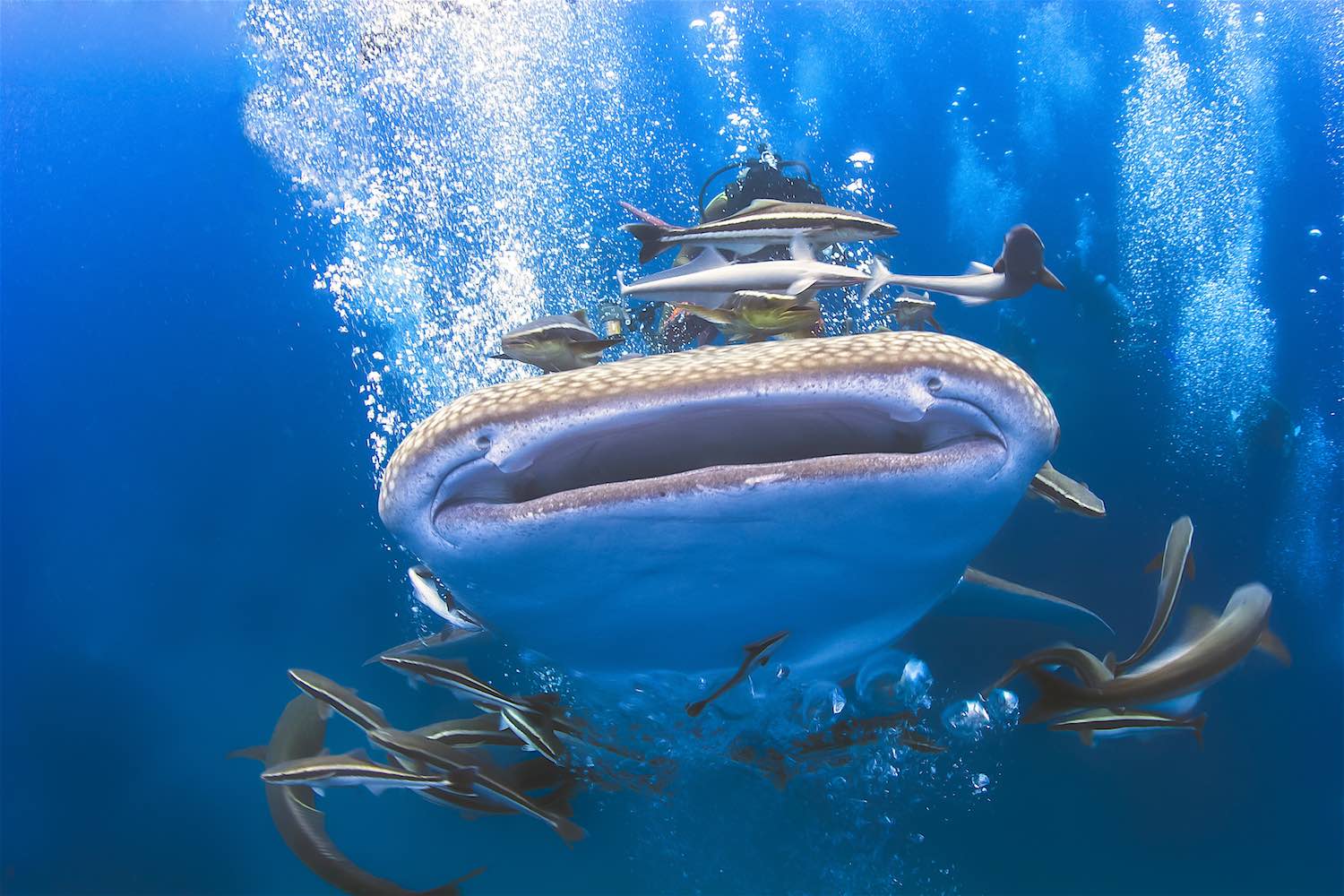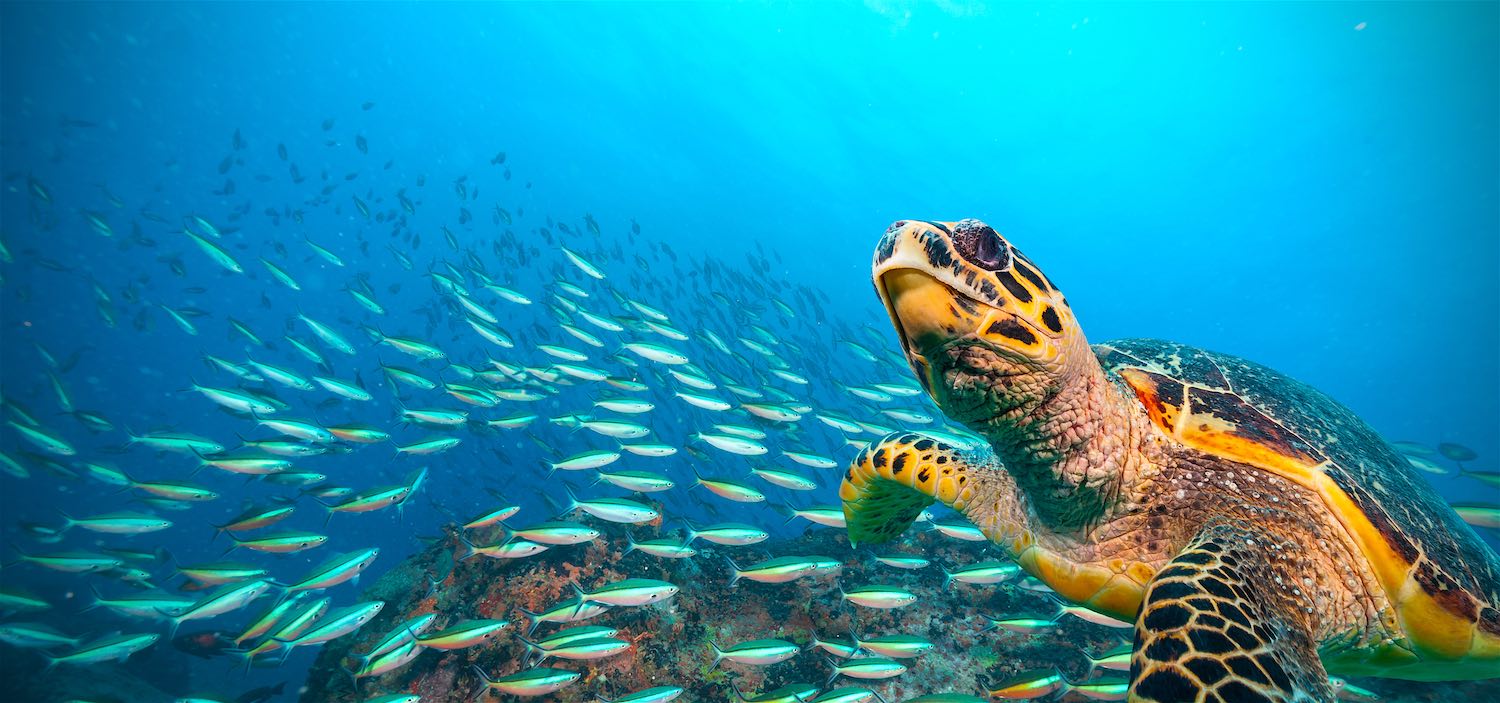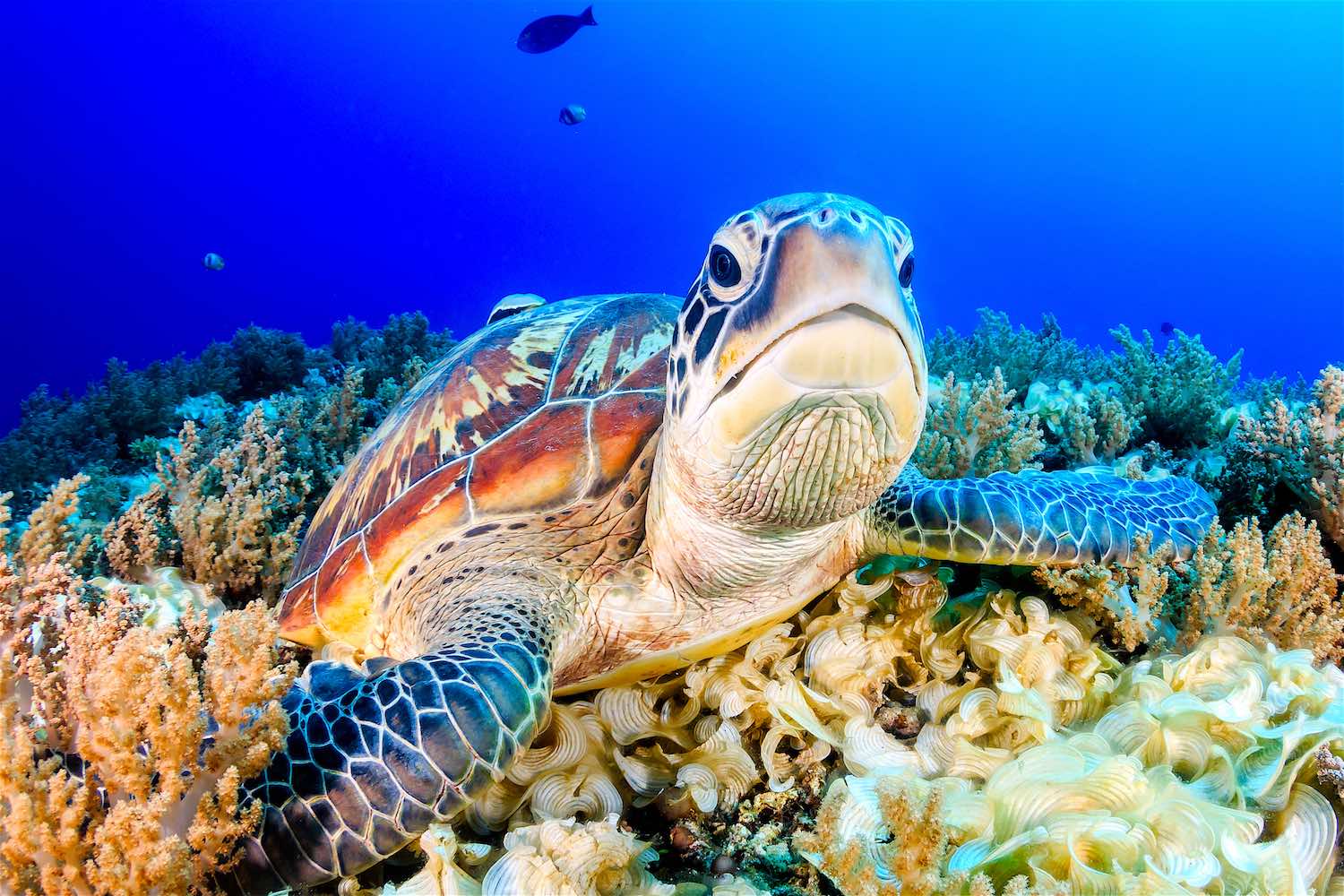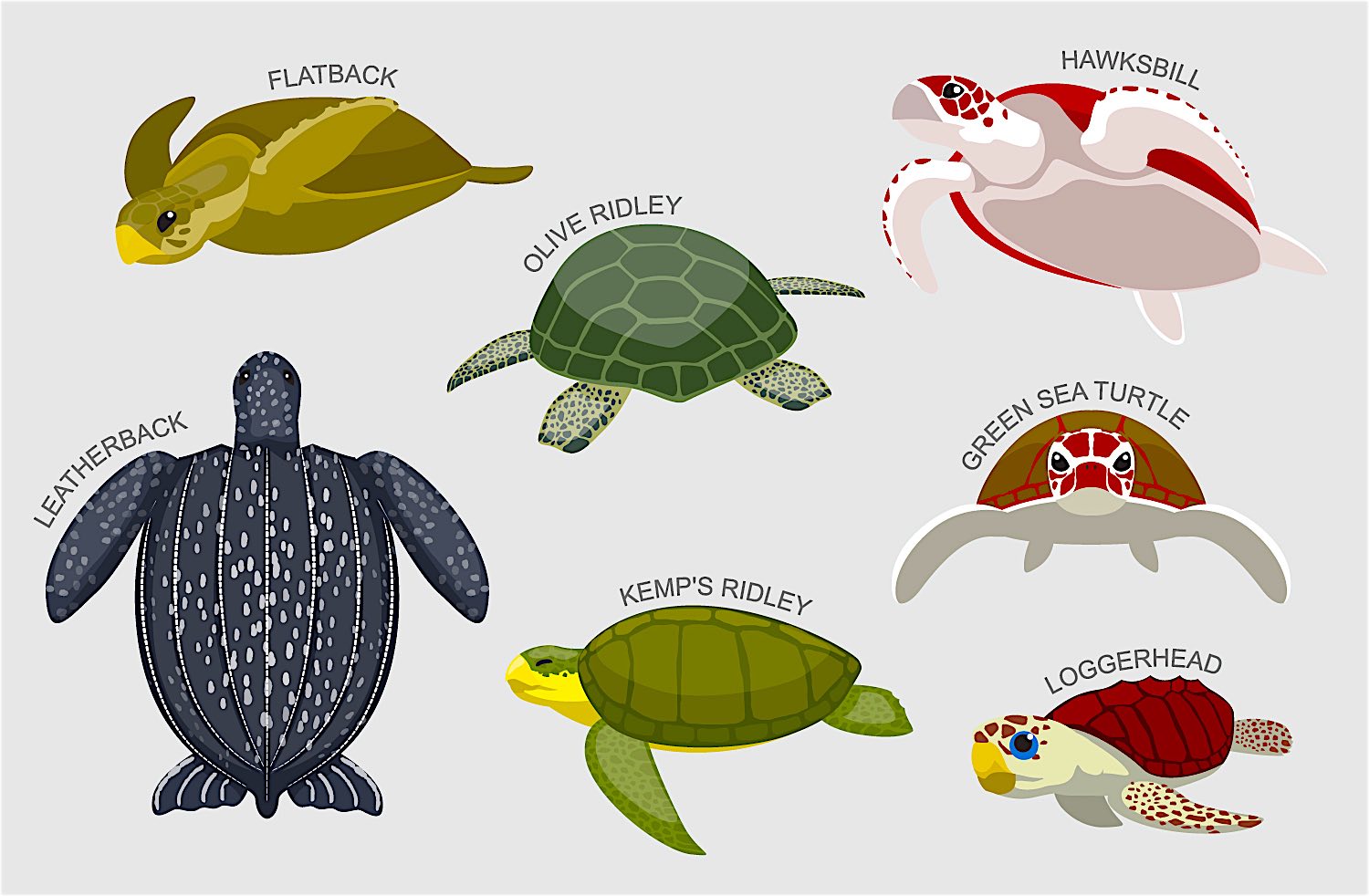Species of Sharks & Turtles Endangered in Thailand
Thailand is home to a number of endangered, threatened and near threatened marine life and it is extremely important to promote awareness and the protection of these animals.
When Scuba Diving, the most popular animals that people often hope to see are sharks and Turtles but unfortunately, numbers have been decreasing drastically over the years.

Different Types of Endangered Sharks
Sharks are apex predators and they play a very important role within the ecosystem. Being top of the marine food chain, they regulate the population of species below them and if sharks were to disappear, then so will many other species.
Their primary source of food is fish, crustaceans, molluscs, krill, marine mammals and other sharks.
They help to weed out the sick and the weak that helps to keep the balance within the ecosystem, ensuring proper proportion.

Whalesharks (Rhincodon Typus) around Koh Tao
Quite often seen around the safe waters of Koh Tao whilst scuba diving and snorkeling and at our popular dive sites, these gentle giants get their name due to their large size, much like several species of whale.
They are the largest fish in the global oceans and can reach lengths of up to 12 metres, however, the average size often seen is usually 4-5 metres long.
Light coloured stripes and spots adorn their bodies, each one unique, much like the fingerprints on a human.
Whalesharks
These magnificent creatures are filter feeders, using their 300 odd rows of small teeth in their large open mouths to scoop up plankton and various vegetation as they swim.
They pose absolutely no threat to humans whatsoever, however, they have been known to avoid all human interaction when frightened.

Endangered Leopard Shark (Triakis) or Zebra Shark
As juveniles, these nocturnal creatures have stripes atop their bodies, which is the reason for their less commonly used name of Zebra Shark.
As they grow to adulthood, the stripes become spots, much like a Leopard’s. Along with their grey and sandy body colour, they are mostly recognised for their three pointed teeth.
Leopard Sharks are the largest egg laying shark in the ocean, growing no bigger than 1.5metres with a lifespan of up to 25-35 years.
These sharks are docile during the day and can often be found resting on the seabed, feeding on living invertebrates. They are harmless to humans but can be skittish when frightened.
These sharks have been seen around Shark Island around Koh Tao but have slowly declined over recent years.

Black Tip Reef Sharks (Carcharhinus Limbatus) around Koh Tao
Instantly recognisable by their black tipped snouts and dorsal fins, these sharks have the traditional, sleek and slender shape that a typical shark is thought to look like.
Baby Black Tip Reef Sharks can be found around the Shark Bay area of Koh Tao as the area is used as a nursery for their young, with the adults located in deeper water to the north-east of Shark Island.
Black Tip Reef Sharks Koh Tao
It’s not unusual to be able to see Baby Black Tip Reef Sharks whilst on a snorkel trip or whilst scuba diving around the south east of Koh Tao.
They are often found in small groups, within warm and shallow, coastal waters. These sharks are of average size, usually growing to around 180cm in length and are viviparous (give birth to live young).
The Black Tip Reef Shark usually prey on small fish and invertebrates, mullet, groupers, wrasses, cuttlefish, squid and shrimp but have been known to eat much smaller sharks and rays.
These creatures are absolutely harmless to humans but due to their extremely shy nature, extra precaution must be taken when scuba diving or snorkeling so as not to startle them.

Endangered Bull Sharks (Carcharhinus Leucas)
These sharks were once popular around the waters of Koh Tao at the deeper outlying dive sites, such as Chumphon pinnacle and Sail Rock, however, these days they are a rare sighting, if at all.
The Bull Shark is known for their short, blunt snout (much like their namesake) and for head-butting their prey before attacking.
The Bull Shark is one of the most dangerous sharks in Asian waters due to their ability to swim in both seawater and freshwater, so they not only can be found roaming the ocean but also in rivers.
These fast creatures can grow to over 3 metres and have stout silhouettes with long pectoral fins.
They are known to be quite aggressive, eating almost anything they can find including dolphins and even other sharks.
These animals are also at a high risk of pollution, more so than any other shark, due to their fondness of exploring areas close to human population.

Endangered Sea Turtles around Koh Tao
Sea Turtles are among the oldest and most primitive groups of reptiles, spending the majority of their lives in the water.
They are born on land and only ever return to land when the adult females need to lay eggs. These majestic creatures are strong, graceful swimmers using their flippers like paddles to glide through the ocean.
Sea Turtles
Although they rarely leave the ocean depths, they do need air to function and will break at the surface to breathe.
These amazing creatures are known to allow divers to come close and will stay unbothered as long as there is no threat and they are not frightened.
There are only 7 existing species of Sea Turtle in the world, all labelled as threatened, endangered or critically endangered.

Endangered Hawksbill Turtle (Eretmochelys imbricata) Koh Tao
Hawksbill Turtles can be seen around the safe waters of Koh Tao by day and night roaming the coral reefs hunting for food.
The best way to see one is to try scuba diving or join a full day snorkel trip around Koh Tao. The guides on the snorkel boats tend to know where to look so you can enjoy the pleasure of a sighting.
Hawksbill Sea Turtle
These Sea Turtles have distinct features such as their tapered head that end in a sharp point resembling a hawk’s beak, these Turtles are quite easily identifiable.
They are not particularly large in size and can grow to around 114cm in shell length plus 68kg in weight.
Both male and female Hawksbill Turtles have a flattened body shape and a pair of claws adorning each flipper but males tend to have much longer claws, thicker tails and are somewhat brighter than their female counterparts.
Their hard shell protects them from predators but they do fall prey to sharks, large fish and humans.

Life Expectancy of a Hawksbill Sea Turtle
With a life expectancy of 30-50 years, these reptiles are highly migratory and spend time in the open ocean, in lagoons and shallow reefs resting in caves or ledges.
Every 2 years, the females are known to return to land and nest, laying their eggs in the sand.
Hawksbill Turtles are omnivores, they eat sponges, soft coral, molluscs, marine algae, crustaceans, sea urchins, fish and jellyfish.
Hawksbill Turtles are labelled critically endangered due to unhatched eggs being hunted and eaten by numerous land dwelling species including humans.
Newly hatched Hawksbill Turtles often fall victim to several sea predators and adults are often killed for their flesh and their shells.

Endangered Green Sea Turtle (Chelonia mydas) Koh Tao
Another popular visitor to the calm, safe waters of Koh Tao are the Green Sea Turtles who can be seen whilst snorkeling in one of the many bays of the island.
With green skin and brownish olive shells, the Green Sea Turtles certainly do live up to their name being the only herbivores among their species.
Although the adults enjoy the taste of algae and various sea grasses, the juveniles tend to eat invertebrates like crabs, jellyfish and sponges.
Green Sea Turtles
The Green Sea Turtle is one of the largest Sea Turtles in the world and can weigh up to 300kg. They have a non-retractable head, with a smooth shell and the males are slightly larger than the females and tend to have a longer tail.
The Green Sea Turtle is classified as endangered due to the over harvesting of their eggs, the loss of nesting beach sites by human encroachment and the hunting of adults.
Many adults are found trapped in fishing nets, killed for their meat and their eggs whilst also suffering the effects of human pollution.

Endangered Olive Ridley Turtle (Lepidochelys olivacea)
These warm water lovers are named after their Olive coloured carapace. They have heart shaped, slightly rounded bodies and are only roughly 2 feet in shell length, making them the smallest of all the Turtle species.
The females are slightly more rounded than the males whereas the males have a longer, thicker tail however, both are virtually the same size.
Olive Ridley are carnivorous Turtles, eating jellyfish, sea urchins, snails, shrimp, crabs and rock lobsters.
Olive Ridley Turtle
Many females nest twice a year, laying up to 100 eggs or more at a time. They are the only species to gather together, migrate and come ashore to lay eggs all at the same time in a mass-nesting event called an Arribada.
Although the Olive Ridley Turtle is known to be the most abundant of all sea Turtles, they are still classed as a vulnerable species and are susceptible to many dangers.
The adults frequently fall victim to sharks and humans and the juveniles often fall victim to birds, snakes and crabs.
They have very few remaining nesting sites across the world and are often caught up in man-made fishing lines.

Endangered Leatherback Turtle (Dermochelys coriacea)
Known for their thick, leathery skin and their dark blue, rubbery carapace, the Leatherback Turtle is the largest of all sea Turtles.
They can grow up to 7ft long and weigh over 2000 pounds. They have a teardrop shaped body and flexible shells, which looks very different to the other Sea Turtles who are all known to have hard, bony outer shells.
Leatherback Sea Turtles
Leatherbacks have large front flippers with no claws and dive deeper than any other sea Turtle, staying under for up to 85 minutes at a time.
Their diet consists mainly of jellyfish but they will also eat sea urchins, squid, fish and molluscs.
Reaching maturity at roughly 16 years old, these magnificent creatures are thought to have a lifespan of at least 30 years.
Climate change is having an increasing impact on their nesting sites.
All marine life is important and must be protected whilst it still can be. Of course, sharks and Turtles are not the only aquatic life out there suffering.
Outside of endangered species of sharks and Turtles, there are other endangered marine species to consider in particular Sawfishes, Manta Rays, Devil Rays and the Bowmouth Guitarfish.


















